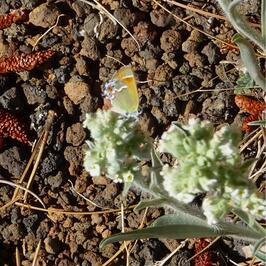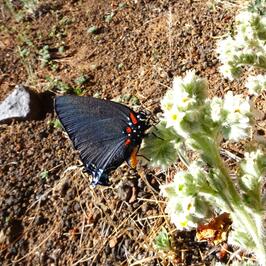Indicator species
“It is that range of biodiversity that we must care for – the whole thing – rather than just one or two stars.” — David Attenborough
A unifying theme of the natural world is connectivity. No species stands alone (for very long); they and we are all connected through predation, pollination, food, nutrients, and water. Much of that connectivity occurs unseen underground via fungi, algae, and bacteria facilitating the transfer of water and nutrients to above-ground vascular plants. Ultimately our survival is linked to sustaining those connections, for the oxygen we breathe, the food we eat, for regulating the climate we depend on, and arguably for our mental well-being. The complexity of these connections can easily overwhelm our capacity to understand and appreciate the importance of ensuring that we protect “the whole thing," and so ecologists, naturalists, and conservationists have adopted a shorthand of species categories. “Keystone species” are so named because of their key influence on sustaining higher levels of biodiversity, but at some level, because of the afore mentioned connectivity, aren’t all species influencing higher levels of biodiversity?
How many connections need to be identified before a species becomes “elevated” to being a keystone species? Identifying a species as a keystone identifies it as a conservation priority, but there are no criteria for establishing which species are more of a keystone than others. Perhaps a more useful term might be “umbrella species,” referring to species that, if they are adequately protected also result in protection for a broad range of regional biodiversity under that protection “umbrella.” Classic umbrella species include broad-ranging predators such as wolves, coyotes, mountain lions, and grizzly bears, but also species which provide food and structure, such as trees, especially where trees are uncommon, such as deserts. Joshua trees clearly fit into that category of being an umbrella species; provide adequate protection for Joshua trees and a huge chunk of the biodiversity of the Mojave Desert would also benefit.
Another category is “indicator species,” referring to species that are particularly sensitive to environmental change and so by their presence in sustaining populations provide an indication that the complexity of nature is operating within “normal” levels. An often-used metaphor for an indicator species is the “canary in the coal mine.” During the early years of coal mining, miners would bring a caged songbird into the coal mine each day; the birds were more sensitive than the miners to dangerous gases that could accumulate in the mine adits. So when a bird passed out the miners knew it was time to get back to the surface – fast.
Ideal indicator species are those that are especially sensitive to environmental changes such as pollution, increased temperatures, and/or changes in aridity. Perhaps surprisingly, given the harsh conditions where they live, lichen have been identified as indicators of air pollution. As air pollution levels increase, lichen species diversity and abundance are reduced. Like lichen, ideal indicators are not just individual species, but are associations of similar easily observed and identifiable species. Not all of those associated species will have identical environmental sensitivities, and so how those individual species change in abundance over time can provide a barometer of environmental change.
There are good arguments for using birds, plants, lichen, or lizards as indicators of change. However, there is a growing appreciation for pollinators, butterflies, moths, bees, and wasps as indicator species. These species groups include lots of species, but unlike most birds and lizards, provide a vital ecological role in facilitating sexual reproduction in flowering plants, and have complex life cycles that include both larval and adult stages, stages that typically require very different resources. Butterflies and moths often have specific larval food plants, but then are more diverse as to which flowers they will visit (and pollinate) as adults. Their environmental sensitivity could be related to the abundance and health of larval food plants, and/or to the availability of flowering plants from which the adult butterflies drink nectar and gain sufficient energy and nutrients for the butterfly’s reproduction. The same could be said for bees and wasps, except that they provision their larva with food in protected chambers whereas butterfly caterpillars are mostly free-roaming and are subjected to both the quality of food plants and being preyed upon by birds, lizards, and parasitic flies and wasps.
One advantage of butterflies as indicator species is that there are relatively easy to use field guides for identifying butterfly species, whereas keys for moths, bees, and wasps are less available and species differences less clear using just binoculars and cameras. Bee and wasp identification can involve collecting individuals and sending specimens to experts to verify species’ IDs. Moth identification may also need the support from expert taxonomists. It often requires using a black light and white sheet at night; most moths are nocturnal and are irresistibly attracted to the glow of a black light.
Butterfly field guides often provide more than just identifying key identification marks. They often also list critical food plants for the caterpillars of each species. We all know that Monarch and Queen caterpillars require milkweeds as food plants. When we see the butterflies are the food plants nearby? Tiger swallowtails need sycamores, willows, or cottonwoods; great purple hairstreaks require mistletoe; juniper hairstreaks need, not surprisingly, junipers; California sisters (and Arizona sisters) need oaks; western green hairstreaks require buckwheat. Learning these relationships adds new dimensions to what it means to be a naturalist – its more than developing an eye for field marks, it starts creating an understanding of those many connections between species.
Tracking population changes in birds, plants, lizards, and/or butterflies, enables us to ask and answer questions about how well we are coexisting with nature. We can measure the impacts of invasive species, effects of climate change, what species are most sensitive, where across a natural landscape might be places that buffer species from a warmer-drier future, as well as whether landscaping with native plants around our homes can provide species’ habitat, and if so is that habitat sufficient to offer climate refugia? Rather than a focus on the success or failure of protecting a few charismatic species (“stars”), the measure of our success in coexisting with our fellow inhabitants should be based on protecting the range of biodiversity.
Nullius in verba
Go outside, tip your hat to a chuckwalla (and a cactus), think like a mountain, and be safe.

